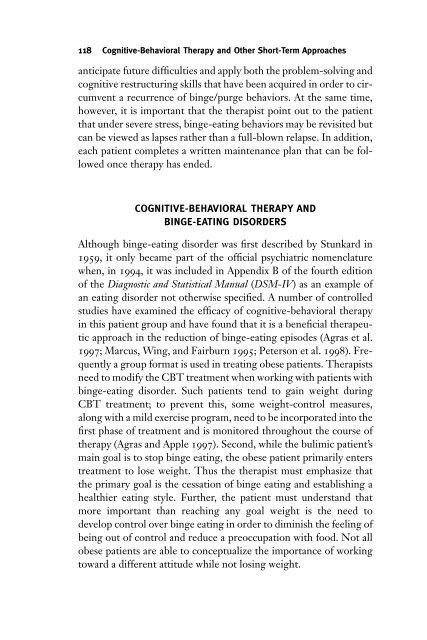Eating Disorders - fieldi
Eating Disorders - fieldi
Eating Disorders - fieldi
You also want an ePaper? Increase the reach of your titles
YUMPU automatically turns print PDFs into web optimized ePapers that Google loves.
118 Cognitive-Behavioral Therapy and Other Short-Term Approaches<br />
anticipate future difficulties and apply both the problem-solving and<br />
cognitive restructuring skills that have been acquired in order to circumvent<br />
a recurrence of binge/purge behaviors. At the same time,<br />
however, it is important that the therapist point out to the patient<br />
that under severe stress, binge-eating behaviors may be revisited but<br />
can be viewed as lapses rather than a full-blown relapse. In addition,<br />
each patient completes a written maintenance plan that can be followed<br />
once therapy has ended.<br />
COGNITIVE-BEHAVIORAL THERAPY AND<br />
BINGE-EATING DISORDERS<br />
Although binge-eating disorder was first described by Stunkard in<br />
1959, it only became part of the official psychiatric nomenclature<br />
when, in 1994, it was included in Appendix B of the fourth edition<br />
of the Diagnostic and Statistical Manual (DSM-IV) as an example of<br />
an eating disorder not otherwise specified. A number of controlled<br />
studies have examined the efficacy of cognitive-behavioral therapy<br />
in this patient group and have found that it is a beneficial therapeutic<br />
approach in the reduction of binge-eating episodes (Agras et al.<br />
1997; Marcus, Wing, and Fairburn 1995; Peterson et al. 1998). Frequently<br />
a group format is used in treating obese patients. Therapists<br />
need to modify the CBT treatment when working with patients with<br />
binge-eating disorder. Such patients tend to gain weight during<br />
CBT treatment; to prevent this, some weight-control measures,<br />
along with a mild exercise program, need to be incorporated into the<br />
first phase of treatment and is monitored throughout the course of<br />
therapy (Agras and Apple 1997). Second, while the bulimic patient’s<br />
main goal is to stop binge eating, the obese patient primarily enters<br />
treatment to lose weight. Thus the therapist must emphasize that<br />
the primary goal is the cessation of binge eating and establishing a<br />
healthier eating style. Further, the patient must understand that<br />
more important than reaching any goal weight is the need to<br />
develop control over binge eating in order to diminish the feeling of<br />
being out of control and reduce a preoccupation with food. Not all<br />
obese patients are able to conceptualize the importance of working<br />
toward a different attitude while not losing weight.









